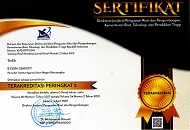RAISING AWARENESS OF LEARNING STRATEGY IN LISTENING FOR TERTIARY EFL LEARNERS
Abstract
Suffering from lacks of supporting instructional materials and teaching methodology are suspected to be the sources of students’ low ability in listening. Other source that influences the students’ insufficiency is lack of learning strategy. In line with the awareness of learning strategy in listening, such concept is believed to contribute promising solution for two main reasons: clear theoretical framework and empirical experiences taking place around the world. Consequently, it is considerably important to teach listening by applying the concept of learning strategy within classroom learning process and outside as well.
Key words: learning strategy, listening, listening strategies, strategy-based instruction
Full Text:
PDF (Bahasa Indonesia)References
Bacon, S. M. 1992. Authentic listening in Spanish: How learners adjust their strategies to the difficulty of the input. Hispania, 75(2), 398-412.
Berne, J. E. 2004. Listening compre-hension strategies: Review of the literature. Foreign Language Annals, 37(4), 521-533.
Bialystok, E. 1981. The role of conscious strategies in second language proficiency. The Modern Language Journal, 65(1), 24-35.
Boyle, J. P. 1984. Factors affecting listening comprehension. ELT Journal, 38(1), 34-38.
Brown, G., and Yule, G. 1983. Teach-ing the spoken language. Cambridge: Cambridge University Press.
Carrier, K. A. 2003. Improving high school English language learners second language listening through strategy instruction. Bilingual Research Journal, 27(3), 383-411.
Chamot, A. U. 2005. Language learning strategy instruction: Current issues and research. Annual Review of Applied Linguistics, 25, 112-130.
Chen, Y. 2007. Learning to learn: the impact of strategy training. ELT Journal, 61(1), 20-29.
Cohen, A. D. 1998. Strategies in learn-ing and using a second language. Essex: Addison Wesley Longman Limited.
Cross, J. 2009. Effect of listening strategy instruction on news video-text comprehension. Language Teaching Research, 13(2), 151-176.
Dunkel, P. A. 1986. Developing listen-ing fluency in L2: Theoretical principles and pedagogical consi-deration. The Modern Language Journal, 70(2), 99-106.
Field, J. 1998. Skills and strategies: towards a new methodology for listening. ELT Journal, 52(2), 110-118.
Field, J. 2000. Not waving but drowning: a reply to Tony Ridgway. ELT Journal, 54(2), 186-195.
Flaitz, J., Feyten, C., Fox, S., and Mukherjee, K. 1995. Raising general awareness of language learning strategies: A little bit goes a long way. Hispania, 78(2), 337-348.
Goh, C., and Taib, Y. 2006. Meta-cognitive instruction in listening for young learners. ELT Journal, 60(3), 222-230.
Goh, C. C. M. 1998. How ESL learners with different listening abilities use comprehension and tactics. Language Teaching Research, 2(2), 124-147.
Griffiths, C. 2007. Language learning strategies. ELT Journal, 61(2), 91-99.
Liu, X., and C.M.Goh, C. 2006. Improv-ing second language listening: Awareness and involvement. In T. S. C. Farrell (Ed.), Language teacher research in Asia. Alexandria, Virginia: TESOL, Inc.
Long, D. R. 1989. Second language listening comprehension: A schema-theoretic perspective. The Modern Language Journal, 73(1), 32-40.
Manchon, R. M. 2008. Taking strategies to the foreign language classroom: Where are we now in theory and research? International Review of Applied Linguistics in Language Teaching, 46(3), 221-243.
O'Malley, J. M., Chamot, A. U., and Kuper, L. 1989. Listening compre-hension strategies in second language acquisition Applied Linguistics, 10(4), 418-437.
Oanh, D. T. H. 2006. Learner autonomy in an Asian context: Independent learning and independent work at the university level. In T. S. C. Farrell (Ed.), Language teacher research in Asia. Alexandria, Virginia: TESOL, Inc.
Oxford, R., and Crookall, D. 1989. Research on language learning strategies: Methods, findings and instructional issues. The Modern Language Journal, 73(4), 404-419.
Oxford, R. L. 2001. Language learning strategies. In R. Carter and D. Nunan (Eds.), The Cambridge Guide to Teaching English to Speakers of Other Languages. Cambridge: Cambridge University Press.
Pickard, N. 1996. Out-of-class language learning strategies. ELT Journal, 50(2), 150-159.
Richards, J. C. 1987. Listening comprehension. In M. H. Long and J. C. Richards (Eds.), Methodology in TESOL. Boston, MA: Heinle and Heinle.
Ridgway, T. 2000. Listening strategies- I beg your pardon? ELT Journal, 54(2), 179-185.
Rost, M. 1990. Listening in language learning. New York: Longman.
Rubin, J. 1994. A review of second language listening comprehension research The Modern Language Journal, 78(2), 199-221.
Sheerin, S. 1987. Listening compre-hension: teaching or testing? ELT Journal, 41(2), 126.
Thompson, I., and Rubin, J. 1996. Can strategy instruction improve listening comprehension? Foreign Language Annals, 29(3), 332-343.
Ur, P. 1984. Teaching listening comprehension. Cambridge: Cambridge University Press.
Vandergrift, L. 1998. Succesful and less succesful listeners in French: What are the strategy differences? The French Review, 71(3), 370-395.
Vandergrift, L. 1999. Facilitating second language listening comprehension: acquiring successful strategies. ELT Journal, 53(3), 168-176.
Vandergrift, L. 2004. Listening to learn or learning to listen? Annual Review of Applied Linguistics, 24, 3-25.
Vandergrift, L. 2005. Relationship among motivation orientation, metacognitive awareness and pro-ficiency in L2 listening. Applied Linguistics, 26(1), 70-89.
Vandergrift, L. 2007. Recent develop-ment in second and foreign language listening comprehension research. Language Teaching Research, 40, 191-210.
Vogely, A. 1995. Percieved strategy use during performance on three authentic listening tasks. The Modern Language Journal, 79(1), 41-56.
Vogely, A. 1998. Listening compre-hension anxiety: Students' reported sources and solution. Foreign Language Annals, 31(1), 67-80.
DOI: http://dx.doi.org/10.31958/jt.v13i2.184
Refbacks
- There are currently no refbacks.
Copyright (c) 2016 SUYONO SUYONO

This work is licensed under a Creative Commons Attribution-NonCommercial-NoDerivatives 4.0 International License.
TA'DIB with registered number e-ISSN: 2580-2771, p-ISSN: 1410-8208 have been indexed on:

Journal Ta'dib distribute under Lisensi Creative Commons Atribusi-NonKomersial 4.0 Internasional.
Contact us: Ta'dib; Address: FTIK, Universitas Islam Negeri Mahmud Yunus Batusangkar; Jl. Sudirman No. 137 Lima Kaum Batusangkar, Tanah Datar, Sumatera Barat, Indonesia. Email: takdib@uinmybatusangkar.ac.id

























